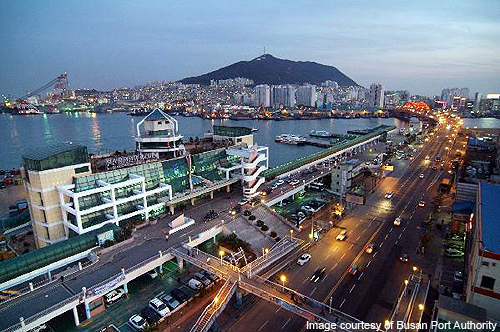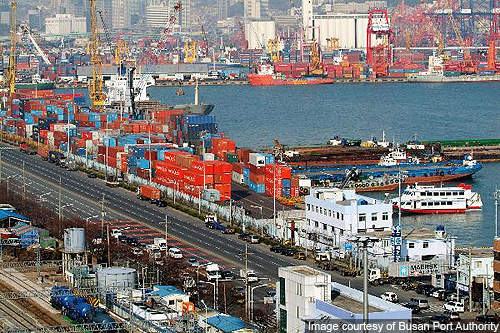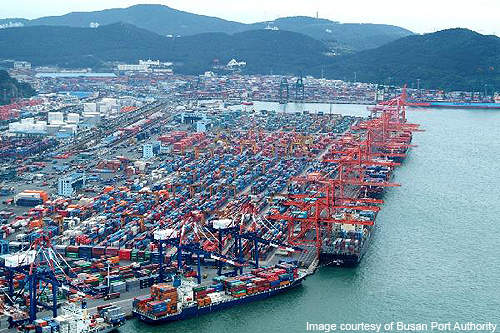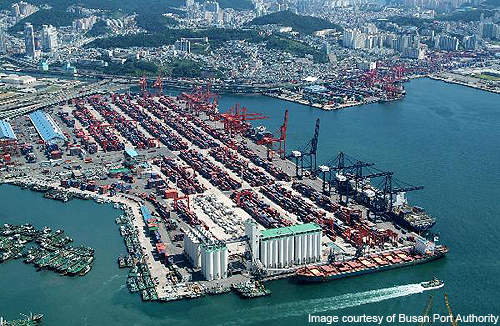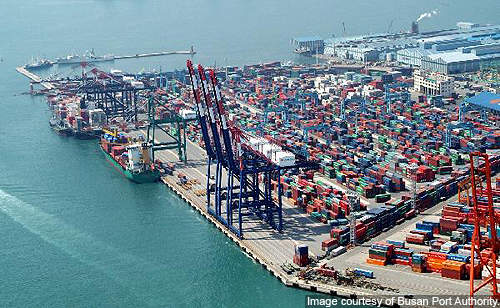The Port of Busan is located at the mouth of the Naktong River in South Korea. It is the fifth busiest container port in the world and the largest transhipment port in north-east Asia. The port was the tenth busiest port in terms of total tonnage and the sixth busiest in terms of 20-foot TEUs of containerised cargo in 2007, as reported by American Association of Port Authorities.
Apart from Jeju City, the Port of Busan was the only city that was not occupied by North Korea during the Korean War (1950-1953). The Port of Busan became a self-governing city after the end of the Korean War. The city has become home for major industries including shipbuilding, automobiles, steel, electronics, chemicals, ceramics and paper.
The Port of Busan is developed, managed and operated by the Busan Port Authority (BPA) which was established in January 2004. The BPA has made it its aim to transform the Port of Busan into a world-class port.
Busan New Port construction
In 1997, the Ministry of Marine and Fisheries (MOMAF) decided to construct a new port 20km west of Busan to alleviate cargo congestion. It was decided to develop a new port, namely Busan New Port, in two phases. Phase one was carried out by a consortium of 11 Korean contractors led by Samsung.
A project for constructing 1.49km of breakwater and 600m of berth was started in October 1997. The project was completed in December 2002 at an investment of KRW123.3bn. Dredging soil ground revetment construction, divided into two construction areas i.e. construction area one and two, were started in September 1999 and May 2000 respectively. Construction area one, involving 8,916m of revetment, 23m of breakwater and 930m of bridge, was completed in November 2004 at an investment of KRW251.3bn. Construction area two, involving 7,401m of revetment was completed in 2004 at an investment of KRW245.8bn.
Construction of the connecting pier, multi-purpose wharf, and entrance passage was started in December 2002.
The connecting pier and multi-purpose wharf project was finished in 2006 at a cost of KRW80bn.
It involved construction of 300m of connecting pier and 400m of multi-purposed pier. For the entrance passage project, 3.76km of entrance passage and 0.46km of adjacent road were constructed. The project was completed in October 2005 at a cost of KRW109.2bn.
Phase 2-3 of the Busan New Port (BNP2-3) officially commenced in January 2012. BNP2-3 is a container terminal with a capacity to handle 2.7 million TEUs annually. It is spread over an area of 840,000m2 and includes four 50,000t berths.
Construction of the terminal commenced in January 2008 and completed in December 2011 at a cost of KRW865bn. It will be maintained and operated by BNCT Co., Ltd for 29 years and three months. Shanghai Zhenhua Heavy Industries completed a 38 rail-mounted crane project for Phase 2-3 in August 2011.
Port facilities
The Busan Port has four fully equipped modern ports – North Port, South Port, Gamcheon Port and Dadaepo Port – an international passenger terminal and six container terminals. The port is facilitated by 26.8km of quay wall, allowing it to berth 169 vessels simultaneously and handle cargo of 91 million tons per annum.
North Port provides cargo and passenger handling facilities. Opened in 1978, the International Passenger Terminal can handle both passengers and cargo. With a length of 460m and alongside depths ranging from one to 8.6m, the terminal’s quay can simultaneously berth one 10,000t, one 3,000t, and two 200t vessels. It is also capable of handling 318,000t of cargo.
South Port is built in area of 90,000m² and has 4,144m of quay length and 400m breakwater. The port houses Busan Cooperative Fish Market which handles 30% of the total marine volume. It is also considered as the largest fishing base in Korea.
Built over an area of 153ha, the Gamcheon Port was developed to supplement the North Port and handle increasing cargo volumes at the Port of Busan. The Gamcheon port has pier processing functions exclusively for marine products and coastal freight.
Dadaepo Port is located in the west of Busan Port and deals mainly with coastal catches. The Dadaepo port will be further developed as an environmental-friendly port. It has 1.2km of breakwater and 593m of revetment.
The quay of the port can berth nine vessels.
Gamman container terminal is built over an area of 750,000m² and is operated by four ship carriers – Global Enterprises, Hanjin Shipping, Korea Express and a foreign company, Hutchison Korea Terminal Ltd. The terminal is equipped with modern container-handling equipment. Quay wall length of the terminal is 1,400m with berthing capacity for four 50,000t vessels. Annual handling capacity of the terminal is 1,280,000TEUs.
Opened in June 1991, the Sinseondae container terminal is equipped with advanced loading / unloading equipment such as high speed container cranes capable of handling post-panamax container ships. The terminal is operated by Busan East Container Terminal Company Limited. Facilities include a quay length of 1,200m and berthing capacity of four 50,000t vessels. Annual handling capacity of the terminal is 1,280,000TEUs.
Singamman container terminal was opened in April 2002 and is operated by Dongbu Pusan Container Terminal Company Limited (DPCT). Its quay length of 826m is capable of berthing two 50,000t vessels and one 5,000t vessel. Built over an area of 308,000m², the terminal has annual handling capacity of 650,000TEUs.
Operating since 1978, the Coastal Ferry Terminal has a quay length of 480.4m with alongside depths ranging from 6m to 8m. Operated by Dongbu Corporation Global Enterprise Limited, the Central Port has a quay length of 646m with alongside depth of 9m.
Port safety
In the wake of the 9/11 attacks in the United States, the port authorities have implemented the International Ship and Port Facility Code (ISPS Code) to heighten the security of ships and port facilities.
Busan port throughput
The Port of Busan handles nearly 40% of the country’s total marine cargo, 80% of its container cargo, and 42% of national fisheries production. The port handles nearly 130 vessels every day.
Total containerised cargo handled by the port in 2007 was 13.3 million TEUs. In addition, the port also handled refrigerated goods of and hazardous goods of nearly 365,000 TEUs. Other containerised cargoes handled during the same year were fertilisers, meat, scrap metal, petroleum and other gases, crude petroleum, coal, leather, fats and oils, iron ore, rough wood, natural sand, milling industry products, and sugar.
The port handled 13.426 million TEUs of container cargo in 2008, which was then the fifth highest annual cargo haul in the world. In July 2010, the port reported a 21.7% year-on-year rise in container cargo throughput. The port handled a total of 1.23 million TEUs of containerised cargo in July 2010.

